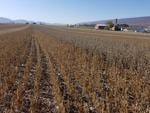Now is the time to consider corn-after-corn rotations.
The strong demand for corn and the recent increase in prices are making many producers consider increasing the amount of corn they grow by expanding their acreage of corn after corn.
Before considering a major switch in rotations, consider the effects on your rotation, crop storage requirements, timeliness of planting conservation plans and ultimately, profitability.
On good soils, the ratio of corn to soybean yields is often 3 to 1. That’s 3 bushels of corn per bushel of soy.
However, on droughty soils, and in some areas of our state, this ratio drops to 2.5-to-1 or less, which makes continuous corn less attractive.
Corn after corn increases the costs of nitrogen and other fertilizers, insecticides and herbicides. In one grain farm assessment we did on low-yielding corn soils, we did not find any benefit to moving to more corn. On higher-yielding soils, it could be more favorable.
On dairy or livestock farms, it would also be good to consider the potential of upping corn grain or silage production to offset purchased grain costs.
Increasing acres of corn following corn has some production considerations.
First is the lack of a nitrogen credit from the previous crop. This will often result in the need for 50 pounds per acre or more of nitrogen than following a 50 bushel-per-acre soybean crop.
A second consideration is that corn usually has 8 to 10% lower yields following corn than following soybeans or alfalfa. On some of our shallow soils, this effect could increase to 20%. On deep river bottom and limestone soils, this “rotation effect” is smaller and may be negligible.
The use of manure and a cover crop mix that includes a legume such as crimson clover will also reduce this penalty. However, it is often difficult to establish cover crops after a late corn grain harvest.
Another consideration is residue management. Planting, especially no-tilling, through fields with heavy corn fodder can be difficult. Delaying planting and using planter attachments that help with wet soils (wavy coulters, spade-toothed closing wheels) will help improve no-till success.
Pest management is another issue. Corn rootworm populations will increase in corn-corn fields. Using a Bt hybrid that’s effective against rootworms or a planterbox insecticide is highly recommended for these situations.
Weed control in corn-corn fields is often straightforward and similar to other rotations, except there may be more risks with controlling volunteer corn, especially if it’s glyphosate tolerant and glyphosate is part of the weed control program.
A final issue is the increased potential for foliar diseases due to fungal spores overwintering on the corn fodder, especially in no-till.
Farmers should select hybrids that have above-average tolerance for gray leaf spot and northern corn leaf blight, as well as good drought and overall stress tolerance. Scout these fields for diseases and consider using fungicides at disease onset.
In summary, corn following corn can be a profitable option, but will require close management, especially in no-till situations where residue levels are high.
With our dairy farm crop rotations, many producers have considerable experience successfully growing corn following corn. Paying attention to the details is a key part of their success.
Now is the time to maintain your planter for optimal no-tilling.
Spring is quickly approaching; avoid planting problems by checking and servicing your equipment now. Poorly adjusted and maintained equipment will reduce your plant stands and lower your grain and silage yields. Penn State Extension soil specialist Sjoerd Duiker has the following reminders:
- Take meter units apart. Check plastic covers, fingers (if applicable), backplates, seed brushes and belt for wear; replace cracked or worn parts; remove dirt and clean parts in good repair; and tighten loose components. If applicable, check that vacuum or air pressure is correct, check for leaks and wear on knock-off brushes, and repair or replace as needed.
- Check the operator manual for the minimum seed opener disk diameter. To check contact, place two business cards between the openers and move them as close together as possible.
- Replace seed tubes if ends are so worn they curl inward, catching seeds. Clean seed sensors if you have them.
- Replace worn seed firmers and adjust tension as necessary.
- Depth wheels should run tight against disks. Change washers from inside to outside (or vice versa) of depth wheel if necessary. Replace the depth wheel arm if this doesn’t resolve the problem.
- Check no-till coulters and row cleaners and replace if needed. Adjust the depth setting as needed.
- Closing wheels must have an intact spring and should be checked for damage or wear. Bearings cannot be wobbly or too tight. The bottoms of rubber or cast-iron closing wheels need to be 1.5 to 2 inches apart. The closing wheel arm cannot have too much play. If so, bushings or the entire arm may need to be replaced.
- Check calibration on each insecticide applicator. Boxes should have no holes or cracks. Tubes should be blown out with air, as should the slot on the bottom of the meter.
- Fertilizer opener disks should have a minimum diameter (check manual). The bearings should not be wobbly or too tight. Service pump and calibrate as needed.
- Check all chains and their sprockets for tension and lubrication. Replace if they are worn or chain links are stiff.
- Make sure planter units are not loose and are level across the planter. Check for loose, worn or missing bolts and bushings. Replace damaged seed hoppers.
- Take a rope and pull it straight from the front coulter to the closing wheels. The firming wheels, seed openers and coulters should all be in line.
- The planter frame should run level within ground; adjust the hitch as needed and inflate tires to the correct pressure.
March 11, 2021 at 05:33PM
https://ift.tt/3tmkTaX
Is Corn After Corn Right for You? | Latest News for Corn, Soybeans, Wheat and more - Lancaster Farming
https://ift.tt/3gguREe
Corn



No comments:
Post a Comment